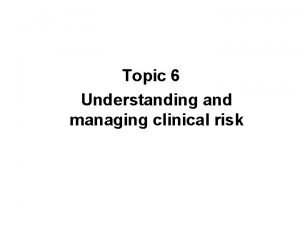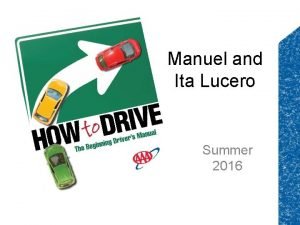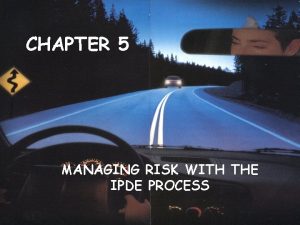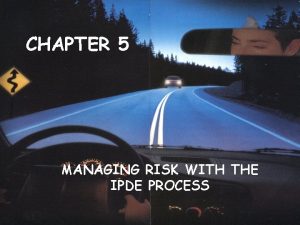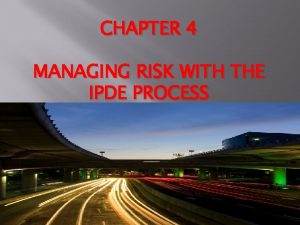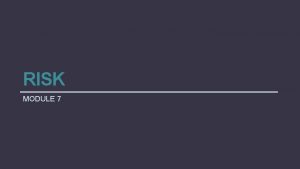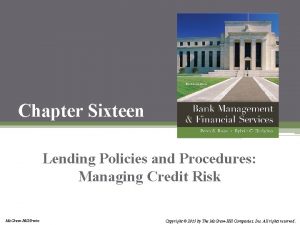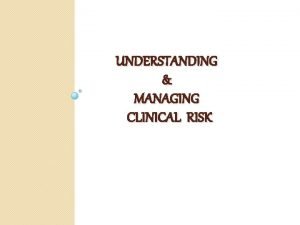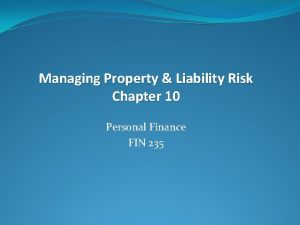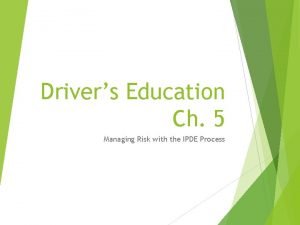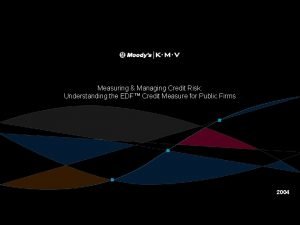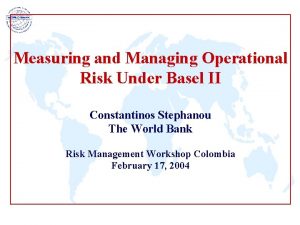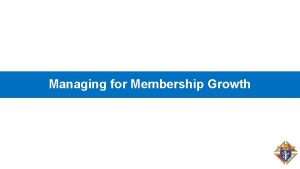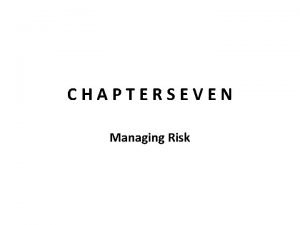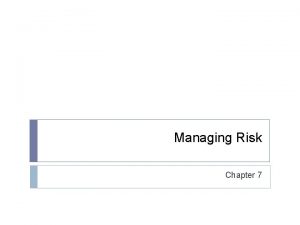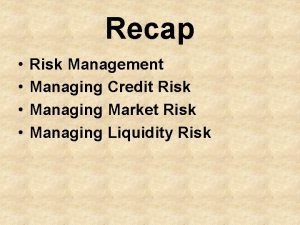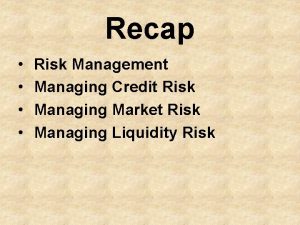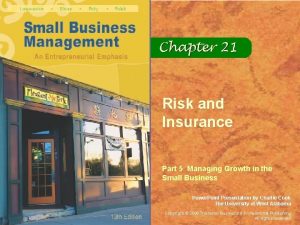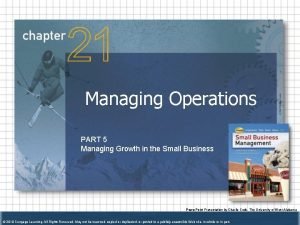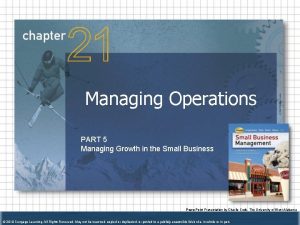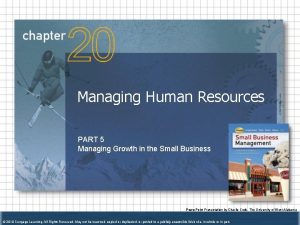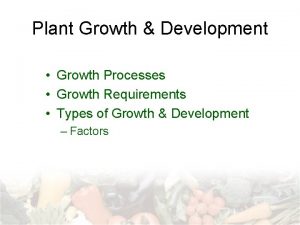Managing Risk Part 5 Managing Growth in the

























- Slides: 25

Managing Risk Part 5 Managing Growth in the Small Business Power. Point Presentation by Charlie Cook The University of West Alabama Copyright © 2006 Thomson Business & Professional Publishing. All rights reserved.

Looking Ahead After studying this chapter, you should be able to: 1. Define risk and explain the nature of risk. 2. Explain how risk management can be used in coping with business risks. 3. Describe the different types of business risk. 4. Explain the basic principles used in evaluating an insurance program. 5. Identify the different types of business insurance coverage. Copyright © 2006 Thomson Business & Professional Publishing. All rights reserved. 2

What is Risk? • Risk – A condition in which there is a possibility of an adverse deviation from a desired outcome that is expected or hoped for • Market Risk – The uncertainty of a gain or a loss associated with an investment decision • Pure Risk – The uncertainty associated with a situation where only loss or no loss can occur—there is no potential for gain (only downside) Copyright © 2006 Thomson Business & Professional Publishing. All rights reserved. 3

Risk Management • Risk Management – Ways of coping with risk that are designed to preserve assets and the earning power of a firm • The Process of Risk Management Step 1: Identify risks. Step 2: Evaluate risks. Step 3: Select methods to manage risk. Step 4: Implement the decision. Step 5: Evaluate and review. Copyright © 2006 Thomson Business & Professional Publishing. All rights reserved. 4

Methods to Manage Risks • Risk Control – Minimizing potential losses by preventing, avoiding, or reducing risk • Loss Prevention – Stopping loss from happening • Loss Avoidance – Avoiding loss by choosing not to engage in hazardous activities • Loss Reduction – Lessening the frequency, severity, or unpredictability of losses Copyright © 2006 Thomson Business & Professional Publishing. All rights reserved. 5

Methods to Manage Risks (cont’d. ) • Risk Financing – Making funds available to cover losses that cannot be managed by risk control • Risk Transfer – Buying insurance or making contractual agreements with others to transfer risk • Risk Retention – Choosing—whether consciously or unconsciously, voluntarily or involuntarily—to manage risk internally • Self-Insurance – Designating part of a firm’s earnings as a cushion against possible future losses Copyright © 2006 Thomson Business & Professional Publishing. All rights reserved. 6

Tools For Managing Risk Note: To find a listing of the risk management tools appropriate for dealing with a potential loss, see the box corresponding to the severity and frequency of the potential loss. Exhibit 21. 1 Copyright © 2006 Thomson Business & Professional Publishing. All rights reserved. 7

Risk Management and the Small Firm • Risk Management Differences from Large Firms: – It is more difficult for small firms to get insurance coverage. – Large firms can assign responsibilities for risk management to a specialized staff manager. – Risk management is not something that requires immediate attention. Copyright © 2006 Thomson Business & Professional Publishing. All rights reserved. 8

The Wheel of Misfortune Classifying Risk by Type of Asset On-Premise Injury Fire Product Liability Natural Disasters Customer Risks Property Risks Bad Debts Personnel Risks Shoplifting Employee Dishonesty Loss of Key Executives Burglary and Business Swindles Competition from Former Employees Copyright © 2006 Thomson Business & Professional Publishing. All rights reserved. Bankruptcy 9

Property Risks • Real Property – Land anything physically attached to the land, such as buildings • Personal Property – Machinery, equipment, furniture, fixtures, stock, and vehicles • Replacement Value of Property – The cost to replace or replicate property at today’s prices • Actual Cash Value (ACV) – An insurance term that refers to the depreciated value of a property Copyright © 2006 Thomson Business & Professional Publishing. All rights reserved. 10

Property Risks (cont’d. ) • Direct Loss – A loss in which physical damage to property reduces its value to the property owner • Indirect Loss – A loss arising from inability to carry on normal operations due to a direct loss of property Copyright © 2006 Thomson Business & Professional Publishing. All rights reserved. 11

Liability Risks: Statutory Liability • Workers’ Compensation Legislation – Laws that obligate the employer to pay employees for injury or illness related to employment, regardless of fault • Contractual Liability – Performance or financial obligations (risks) that firms assume when entering into contracts with other parties Copyright © 2006 Thomson Business & Professional Publishing. All rights reserved. 12

Liability Risks: Tort Liability • Torts – Wrongful acts or omissions for which an injured person can take legal action against the wrongdoer for monetary damages • Establishing Negligence – A legal duty to act (or not to act) to cause injury (damage) – A failure to provide the appropriate standard of care – The presence of actual injury or damages – Action was the proximate cause of injury or damages Copyright © 2006 Thomson Business & Professional Publishing. All rights reserved. 13

Liability Risks: Tort Liability (cont’d. ) • Reasonable (Prudent Person) Standard – The typical standard of care based on what a reasonable or prudent person would have done under similar circumstances • Compensatory Damages – Economic or noneconomic damages intended to make the claimant whole, by indemnifying the claimant for any injuries or damage arising from the negligent action Copyright © 2006 Thomson Business & Professional Publishing. All rights reserved. 14

Torts: Types of Damages • Economic Damages – Compensatory damages that relate to economic loss such as medical expense, loss of income, or the cost of property replacement/restoration • Noneconomic Damages – Compensatory damages for such losses as pain and suffering, mental anguish, and loss of consortium • Punitive Damages – A form of punishment that goes beyond compensatory damages, intending to punish wrongdoers for gross negligence or a callous disregard for the interests of others and to have a deterrent effect Copyright © 2006 Thomson Business & Professional Publishing. All rights reserved. 15

Sources of Tort Liability Premises Liability Professional Liability Employee Liability Vehicular Liability Product Liability Directors and Officers Liability Copyright © 2006 Thomson Business & Professional Publishing. All rights reserved. 16

Business Personnel • Personnel Risks – Risks that directly affect individual employees, but may have an indirect impact on a business as well Premature Death Poor Health Insufficient Retirement Income Copyright © 2006 Thomson Business & Professional Publishing. All rights reserved. 17

Insurance for Small Business • Basic Principles of a Sound Insurance Program – Identifying insurable business risks • Workers’ compensation and automobile liability insurance are required by law. – Limiting coverage to major potential losses • Avoid overspending insurance resources. – Relating premiums to probability of loss • Insure most improbable but critical losses first. Copyright © 2006 Thomson Business & Professional Publishing. All rights reserved. 18

Requirements for Obtaining Insurance • The risk must be calculable so that premiums can be calculated. • The risk must exist in large enough numbers to allow the law of averages to work. • The insured property must have commercial value. • The policyholder must have an insurable interest in the property or person insured. Copyright © 2006 Thomson Business & Professional Publishing. All rights reserved. 19

Common Types of Insurance • Business Owner’s Policy (BOP) – A business version of a homeowner’s policy, designed to meet the property and liability insurance needs of small business owners • BOP Coverage Approaches – Named-peril approach • An approach that identifies the specific perils covered – All-risk approach • An approach that defines the perils covered by stating that all direct damages to property are covered except those caused by perils specifically excluded Copyright © 2006 Thomson Business & Professional Publishing. All rights reserved. 20

Insurance: Valuation • Valuation – Both real and personal property are valued on a replacement-cost basis such that all property damage and loss will be reimbursed at the rate required to rebuild or replace the property • Insurance to Value Provision – Requires the insured to carry a minimum policy limit relative to the actual value of the property – Not contained in most BOPs – Coinsurance provision • Requires that property be insured for at least 80 percent of its value or a penalty will be applied to any covered loss Copyright © 2006 Thomson Business & Professional Publishing. All rights reserved. 21

Coinsurance Example If an insured building had a replacement value of $500, 000, the 80 percent policy limit would require that the property be insured for at least $400, 000 ($500, 000 x 0. 80). If the building was insured for only $300, 000 and an insured loss of $100, 000 occurred, the recovery would be limited to $75, 000, calculated as follows: Copyright © 2006 Thomson Business & Professional Publishing. All rights reserved. 22

Additional BOP Coverage • Business Interruption Insurance – Reimburses a business for the loss of anticipated income plus continuing expenses that cannot be met because of the negative impact of a direct loss on business revenues • Commercial General Liability (CGL) coverage – Covers bodily injury and property damage for which the business is liable • Medical Payments Coverage – Covers injuries of customers and the general public, with no fault required on the part of the insured Copyright © 2006 Thomson Business & Professional Publishing. All rights reserved. 23

Life and Disability Insurance • Key-Person Insurance – Coverage that provides benefits upon the death of a firm’s key personnel • Disability Insurance – Coverage that provides benefits upon the disability of a firm’s partner or other key employee Copyright © 2006 Thomson Business & Professional Publishing. All rights reserved. 24

Key Terms risk market risk pure risk management risk control loss prevention loss avoidance loss reduction risk financing risk transfer risk retention self-insurance real property personal property replacement value of property actual cash value (ACV) peril direct loss indirect loss workers’ compensation legislation torts reasonable (prudent person) standard compensatory damages economic damages noneconomic damages punitive damages proximate cause personnel risks business owner’s policy (BOP) named-peril approach all-risk approach insurance to value coinsurance provision business interruption coverage commercial general liability (CGL) coverage medical payments coverage key-person insurance disability insurance Copyright © 2006 Thomson Business & Professional Publishing. All rights reserved. 25
 Liquidity measures
Liquidity measures Plant growth index
Plant growth index Ground tissue
Ground tissue Carothers equation
Carothers equation Primary growth and secondary growth in plants
Primary growth and secondary growth in plants Primary growth and secondary growth in plants
Primary growth and secondary growth in plants Geometric exponential growth
Geometric exponential growth Neoclassical growth theory vs. endogenous growth theory
Neoclassical growth theory vs. endogenous growth theory Organic vs inorganic growth
Organic vs inorganic growth Managing growth in small business
Managing growth in small business Managing clinical risk
Managing clinical risk Chapter 1 managing risk when driving
Chapter 1 managing risk when driving Ipde process
Ipde process Use the ipde process to separate hazards
Use the ipde process to separate hazards Ipde process definition
Ipde process definition Module 4 topic 5 turnabouts and parking
Module 4 topic 5 turnabouts and parking Module 4 topic 1 assessing and managing risk
Module 4 topic 1 assessing and managing risk Module 7 managing risk answer key
Module 7 managing risk answer key Identifying and managing project risk tom kendrick
Identifying and managing project risk tom kendrick Lending policies and procedures managing credit risk
Lending policies and procedures managing credit risk Managing clinical risk
Managing clinical risk Managing property and liability risk
Managing property and liability risk Chapter 8 managing distractions
Chapter 8 managing distractions An orderly visual search pattern
An orderly visual search pattern Measuring and managing credit risk
Measuring and managing credit risk Measuring and managing operational risk
Measuring and managing operational risk










